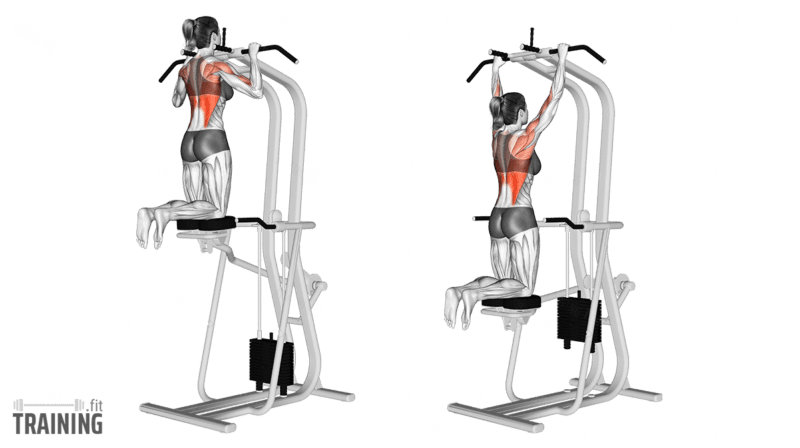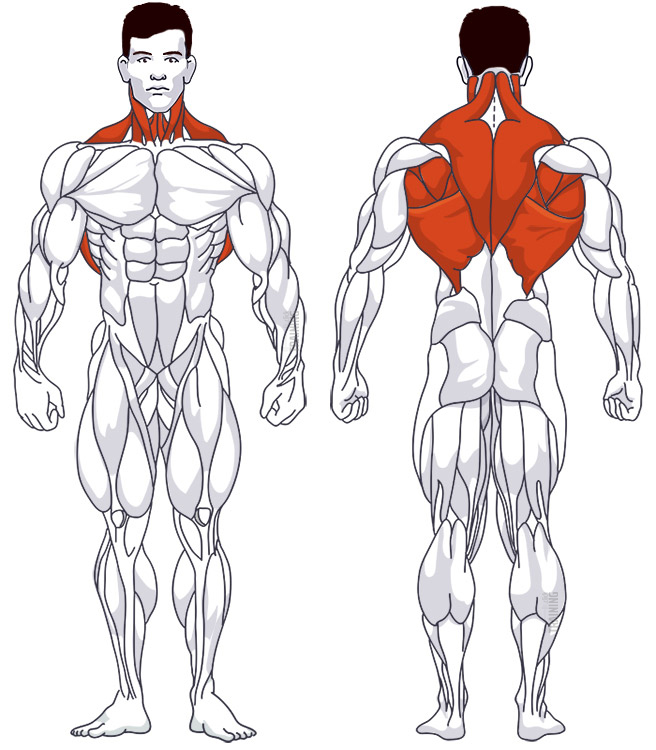Assisted Pull-Ups
Compound exercise, MachineOverview

Main muscles
- Back: Large round muscle
(Musculus teres major) - Back: Large back muscle
(Musculus latissimus dorsi) - Back: Larger rhomboid muscle
(Musculus rhomboideus major) - Back: Small round muscle
(Musculus teres minor)
Training plans
Assisted Pull-Ups is a suitable substitute for similar exercises in or as a supplement to various training plans.
Assisted Pull-Ups: Basics and alternatives

Involved main muscle groups:
Assisted Pull-Ups
Machine-assisted pull-ups are a practical alternative to regular pull-ups, especially for beginners. The motion is the same as regular pull-ups: you hang from a bar and pull your body up, focusing on your back muscles (latissimus dorsi).
The key difference is that machine-assisted pull-ups provide support by pushing you upward with a counterweight. Instead of your legs hanging freely, you kneel on a leg rest that pushes your body up. You can adjust the weight to provide the amount of support you need.
Often, beginners struggle with regular pull-ups because they lack the strength for proper execution. In these cases, it’s normal to struggle with completing clean repetitions. To prepare for unassisted pull-ups, try other upper back exercises as an alternative, like seated machine rows, cable rows, or cable lat pulldowns.
Correct Execution
Performing assisted pull-ups correctly depends on choosing the right weight. A heavier weight on the machine makes the exercise easier, so it’s essential to find the “sweet spot” that still challenges you despite the assistance.
Pull-up machines come in different designs, with some having stepping platforms for easy access to the knee pad. These machines often double as dip machines, allowing you to perform dips with weight assistance using side handles.
Video Tutorial
Step-by-Step Instructions
Set the weight that will ease the load on your back. For example, if you choose 20 kg, you’ll effectively be 20 kg lighter because of the counterweight.
Step onto the footboards and grab the pull-up handles slightly wider than shoulder-width in an overhand grip (back of your hand facing you).
Place your knees on the pad provided. Start by placing one knee on the pad and pushing it down a bit, then place the second knee on the pad. Keep your hands securely on the handles at all times. Now you’re in the starting position on the pull-up machine.
Maintain body tension and pull yourself up. The counterweight can only support your pull-up if you stay tense. If the pull-up is too easy, step off the machine and reduce the weight. If you can’t complete a clean pull-up despite the counterweight, increase the weight.
Common Mistakes
A common mistake is setting the assistance weight too high, making the exercise too easy and reducing the training effect. Try to find the lowest possible assistance weight that still allows for proper execution.